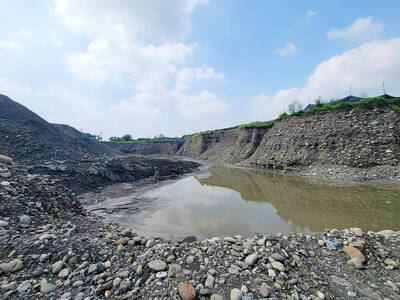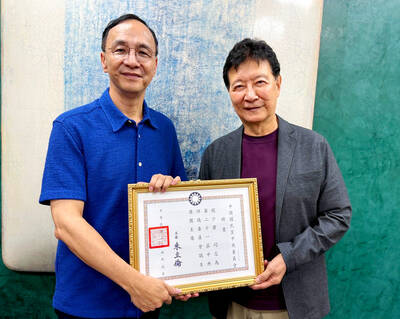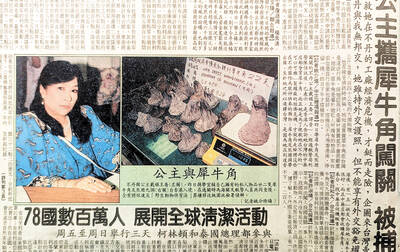VIEW THIS PAGE Wandering out of the Metaphysical Gallery last weekend, I was trying to think of a Taiwanese artist who, over the past few decades, has depicted Taiwan’s natural landscape in a realistic style. Aside from a few sculptors, I couldn’t come up with a single one. This because, perhaps, of recent trends in contemporary art, with its craze for digital media. Or perhaps local artists prefer to represent humans or cityscapes. Regardless, it seems strange that, few, if any, of Taiwan’s artists of late have represented the country’s natural beauty on canvas.
The work of Jang Tarng-kuh (張堂庫) prompted these musings because his 22 pieces currently on display at the gallery do just that. The oil-on-canvas landscape paintings — flowing rivers, verdant foliage and mountain scenes — and still-life paintings of flowers and fruit depict the diversity of lush plants and wide-open perspectives found around Yangmingshan (陽明山), where the 41-year-old artist lives and works.
Jang’s process of creation is similar to that of one of the early impressionists. Prior to applying paint to canvas, he sketches outdoors, scrupulously rendering the movement of a body of water, for example, or the dew on a cabbage leaf. He then returns to his cottage studio and, using the drawings and his memory, proceeds to create his works. He often returns to the forest or field to gain a deeper sense of a branch’s texture or a flower’s color. What results are realistic paintings of exceptional detail that often take two or three years to complete.
Pop of Plantain Trees (芭蕉樹的普普風) is fairly representative of Jang’s mountain landscapes. A cluster of plantains, its vibrant leaves rendered in emerald and malachite take up most of the canvas. A field of yellowish-green grass in the mid-ground stretches into a background of misted mountains — a kind of Garden of Eden idyll of bountiful greenery.
A branch emerging from the top left-hand side of the canvas and leaves shooting up from a riverbank at the lower right are the only hints of perspective in Shining Wave Dancing Shadow (波光舞影). The river reflects opaline shimmers of light from the sky, while a single leaf creates a ripple in the water’s surface, making the branches appear as though dancing. Drizzle at the Pond (湖畔細雨) captures the circling undulations made by gently falling rain on a luminous azure surface tinged with purple and green.
The still-life paintings, though done with domesticated objects such as plates and tablecloths, retain the emblem of plentitude. The five luminous persimmons of Golden Year (鎏金歲月) are placed inside a bowl sitting on a crimson tablecloth with flower patterns.
Less impressive for this reviewer were Jang’s series of domesticated cats frolicking in nature. A feline plays in the luminous undergrowth in Hide and Seek (捉迷藏), while Afternoon Talk (午后) features a cat lounging in a tree as another looks on. Although these canvases retain his impressive palette and attention to detail, they come off more as greeting card images than fine art.
It is frustrating and disappointing that the English-language version of the artist’s introduction — as well as the Chinese-language version on which it was based — offers practically no insight into Jang’s thinking as an artist. Instead it relies on statements such as, “Every present stands on its past track to expect the next splendid instant,” or, “Every today is the tomorrow of yesterday,” as a means of explicating on the artist’s work. How these words are meant to convey to visitors a deeper understanding of an artist who deserves recognition is totally beyond me. VIEW THIS PAGE

Last week the story of the giant illegal crater dug in Kaohsiung’s Meinong District (美濃) emerged into the public consciousness. The site was used for sand and gravel extraction, and then filled with construction waste. Locals referred to it sardonically as the “Meinong Grand Canyon,” according to media reports, because it was 2 hectares in length and 10 meters deep. The land involved included both state-owned and local farm land. Local media said that the site had generated NT$300 million in profits, against fines of a few million and the loss of some excavators. OFFICIAL CORRUPTION? The site had been seized

Next week, candidates will officially register to run for chair of the Chinese Nationalist Party (KMT). By the end of Friday, we will know who has registered for the Oct. 18 election. The number of declared candidates has been fluctuating daily. Some candidates registering may be disqualified, so the final list may be in flux for weeks. The list of likely candidates ranges from deep blue to deeper blue to deepest blue, bordering on red (pro-Chinese Communist Party, CCP). Unless current Chairman Eric Chu (朱立倫) can be convinced to run for re-election, the party looks likely to shift towards more hardline

Sept. 15 to Sept. 21 A Bhutanese princess caught at Taoyuan Airport with 22 rhino horns — worth about NT$31 million today — might have been just another curious front-page story. But the Sept. 17, 1993 incident came at a sensitive moment. Taiwan, dubbed “Die-wan” by the British conservationist group Environmental Investigation Agency (EIA), was under international fire for being a major hub for rhino horn. Just 10 days earlier, US secretary of the interior Bruce Babbitt had recommended sanctions against Taiwan for its “failure to end its participation in rhinoceros horn trade.” Even though Taiwan had restricted imports since 1985 and enacted

The depressing numbers continue to pile up, like casualty lists after a lost battle. This week, after the government announced the 19th straight month of population decline, the Ministry of the Interior said that Taiwan is expected to lose 6.67 million workers in two waves of retirement over the next 15 years. According to the Ministry of Labor (MOL), Taiwan has a workforce of 11.6 million (as of July). The over-15 population was 20.244 million last year. EARLY RETIREMENT Early retirement is going to make these waves a tsunami. According to the Directorate General of Budget Accounting and Statistics (DGBAS), the